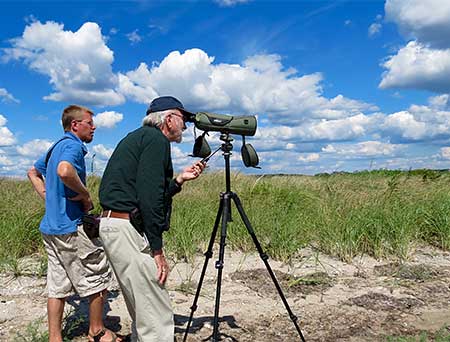
2025 Napatree Point Conservation Area Summer Outreach & Education Programs
REGISTER HERE FOR ALL PROGRAMS
Horseshoe Crab Family Walks
9:00 AM – 10:00 AM
Saturday, June 14, Sunday, July 6
All ages (Registration required)
Explore the fascinating world of horseshoe crabs. Discover why these remarkable “Living Fossils” have survived for over 300 million years, learn about their significant contributions to medical research, and understand their crucial ecological importance to Napatree Point and Little Narragansett Bay. This informative outdoor experience offers a unique opportunity to appreciate these ancient creatures and their role in our local ecosystem. This walk is perfect for all ages!
RI Audubon Society Horseshoe Crab Expedition
6:30 PM – 8:00 PM
Tuesday, June 24
Ages 10+ (Registration required)
Join Audubon and The Watch Hill Conservancy for a unique experience to learn about the fascinating anatomy and life history of horseshoe crabs and their important role in coastal ecosystems. Start with a short introduction and then walk along the beach in search of these captivating critters and the shorebirds that feast on their eggs!
Horseshoe Crab Community Science Program – Project Limulus
Select morning and evenings during the May and June full and new moon high tides
Ages 12+ (Registration required)
Join us for our 19th year participating in Project Limulus, a scientific survey tracking horseshoe crab populations. Volunteers will walk two miles along the Napatree Point Conservation Area during the May and June full and new moon high tides—prime spawning time for these ancient creatures. The survey takes 2-4 hours, depending on horseshoe crab activity (anywhere from zero to a thousand crabs might be encountered). While all are welcome to participate in this important conservation effort, participants should be prepared for the physical demands of the survey. Experience these “living fossils” up close while contributing valuable data to this long-term research program.
Beach Bums Children’s Program
Monday Mornings
9:00 AM – 10:00 AM
June 9, July 14, August 11, September 8
Ages 4-6 (Registration required)
Educational beach time is fun for the little ones. This hour-long program with the Napatree Naturalists will consist of a children’s story and an interactive activity/game covering topics such as Horseshoe Crabs, Shorebirds, Hermit Crabs, and Beach Clean-Up. Each participant will take home a small, child-safe souvenir. Parents must accompany their children.
Beach Bums Yoga (NEW)
Monday Mornings
9:30 AM – 10:15 AM
June 18, July 23, August 20
Ages 4-7 (Registration required)
This children’s yoga beach class is designed to combine the calming benefits of yoga with the fun and excitement of being at the beach. The class will be engaging, interactive, and educational, aimed at children ages 4-7. It focuses on mindfulness, body awareness, and playful movement while incorporating the natural surroundings of the beach. Parents must accompany their children.
Seine Net Program
Saturday Mornings
9:00 AM – 10:30 AM
June 28, July 12, July 26, August 9, August 23, September 6
All ages
Cast a wide net! The Seine Net program highlights the importance of the Little Narragansett Bay ecosystem and its connection to the Napatree Point Conservation Area. Join the Naturalists as they literally cast a large net into the water, catching marine life for up-close and personal examination. Grab your own mini dip net and delight in what you can bring to the surface.
Bird and Learn (NEW)
Sunday Mornings
8:00 AM – 9:30 AM
June 1, July 6, August 3, September 7
Ages 10+
We welcome both new and experienced bird watchers to join us in exploring the variety of bird species in the Napatree Point Conservation Area, recognized as a “Globally Important Bird Area” by the National Audubon Society. During our 2-mile walk, we’ll observe and learn about these beautiful animals, sharing our appreciation and knowledge with each other. This program is open to anyone with a desire to learn about birding or share their expertise. We encourage your curiosity and enthusiasm as we aim to foster lasting connections. A limited number of binoculars will be available for participants.
Natural History Walks
Saturday Mornings
9:00 AM – 10:30 AM
June 21, July 5, July 19, August 2, August 16, August 30
All ages
Join our Naturalists for a themed walk (plants, birds, marine life) based on participants and enjoy this excellent opportunity to learn about the natural history of Napatree Conservation Area.
Napatree Discovery Table
Saturday and Sunday
11:00 AM to 2:00 PM
June 21 to September 6
Visit our interactive information table and meet our Naturalists! Protecting Napatree’s wildlife and habitats is a complex process. Take a self-guided family stroll on beautiful Napatree Point – it’s the perfect opportunity to learn more about the purpose and benefits of our Conservation efforts. Children can touch beachcombing items, shells, crab exoskeletons, and observe wildlife through binoculars and scopes.
Napatree Investigators Program
Tuesday, Wednesday, Thursday
8:30 AM – 10:30 AM
Week 1 – Seining – July 8, 9, and 10
Week 2 – Tidal Pools – July 15, 16, and 17
Week 3 – Crabbing – July 22, 23, and 24
Week 4 – Clamming – July 29, 30, and 31
Week 5 – Lagoon Exploration – August 5, 6, and 7
Week 6th – Beach Combing – August 12, 13, and 14
Ages 7-13 (Registration required)
Foster your child’s curiosity for the flora and fauna of the various habitats and ecosystems of the beautiful beach environment of Napatree Point, a premier RI coastal Conservation Area. With a different environmental theme each week, participating Investigators will spend the morning on the beach with Watch Hill Conservancy Naturalists as they learn and explore. Each child will take home a custom t-shirt as a souvenir of this special opportunity to be up close and personal with nature and the beautiful shoreline.
Discover on Your Own
Nature on Napatree
While exploring Napatree Point, these are some of the wildlife species and habitats you might see. Details of the plant and animal species highlighted here, as well as the geology of Napatree, can be found in the annual State of Napatree reports in the Napatree Resources. For bird watchers, the comprehensive list of birds seen on Napatree and photos of each species that was compiled by Reynold Larsen will be especially interesting.
American Oystercatchers
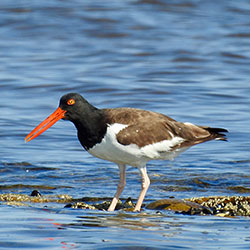
American Oystercatchers (Haematopus palliatus) are an iconic wildlife species on Napatree and are classified as a species of great conservation concern in Rhode Island. These beautiful birds are most common in the mudflats and shallow mussel beds near the Lagoon in the Fall. Adults have bright red, powerful bills that are capable of opening mussels and oysters.
Male and female oystercatchers sometimes mate for life. Males help feed and care for their young, which can be distinguished from adults by the black tip at the end of their bill.
Piping Plover
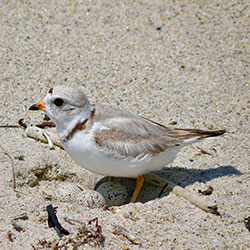
Piping Plovers (Charadrius melodus), a federally threatened species, occur at Napatree from March to September. This small shorebird nests in shallow depressions in the sand, where they typically incubate four eggs for about one month. Mortality of eggs and nestlings can be very high, primarily due to predators or flooding during extreme storm tides.
Piping Plovers feed on insects and worms in the wrack and on the beach. After the breeding season, Piping Plovers migrate to their wintering grounds from North Carolina to the Turks and Caicos Islands.
Osprey
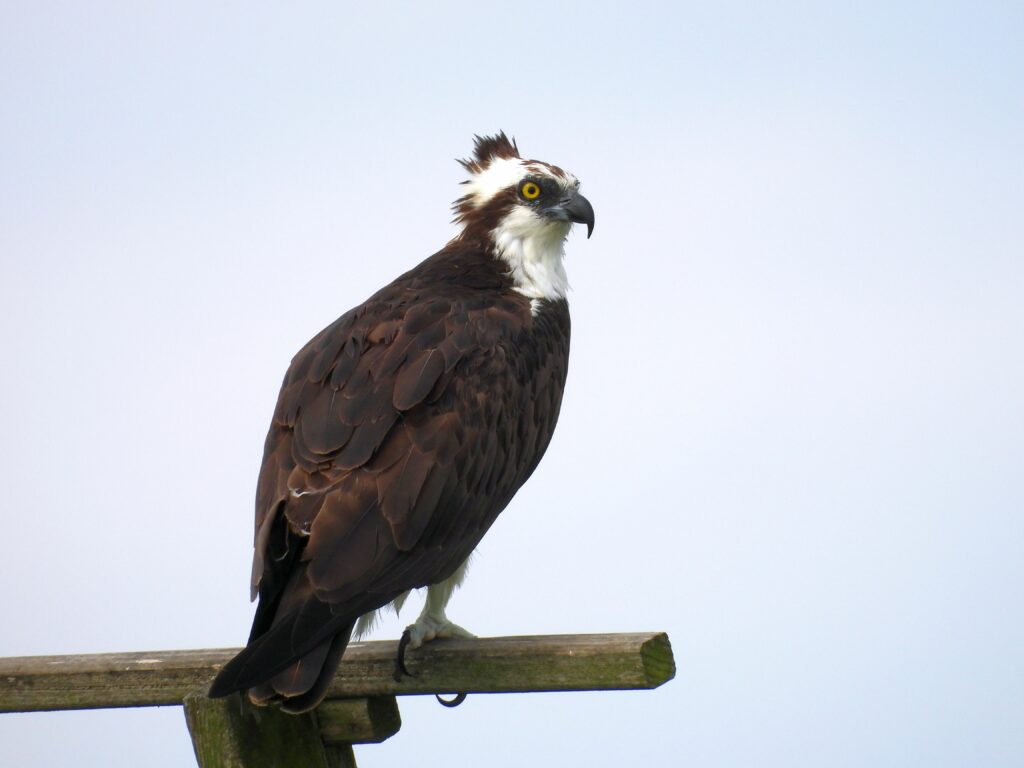
Osprey (Pandion haliaetus) are large fishing-eating hawks. They are considered a species of special conservation concern in Rhode Island. Osprey will fly over the Lagoon and Little Narragansett Bay in search of fish swimming close to the surface. They make dramatic dives from up to 130’ and capture fish in their large talons.
Osprey traditionally nested on Napatree but did not nest in 2016 or 2017. Careful inspection of the nest platform found it was caked with mud so rain water would not properly drain. In the winter of 2018, three new Osprey nest platforms were installed on Napatree in hopes that they will start nesting again.
Northern Harriers
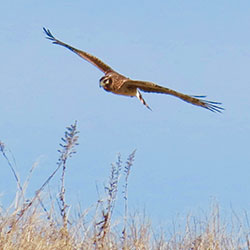
Northern Harriers (Circus cyaneus), sometimes called Marsh Hawks, are migrants that tend to use Napatree during migration and the winter months. They fly back and forth over the dunes in search of mice and voles moving through the dune grass. Their owl-like face is an adaption to increase their hearing capabilities so they can listen for mice moving through the grass.
The white patch at the base of their long tail is a distinctive marking, as is their rocking flight pattern. The presence of Northern Harriers on Napatree nicely shows what a tightly integrated ecosystem it is – sand dunes, dune grass, mice and voles, and Harrier predators.
Horseshoe Crabs
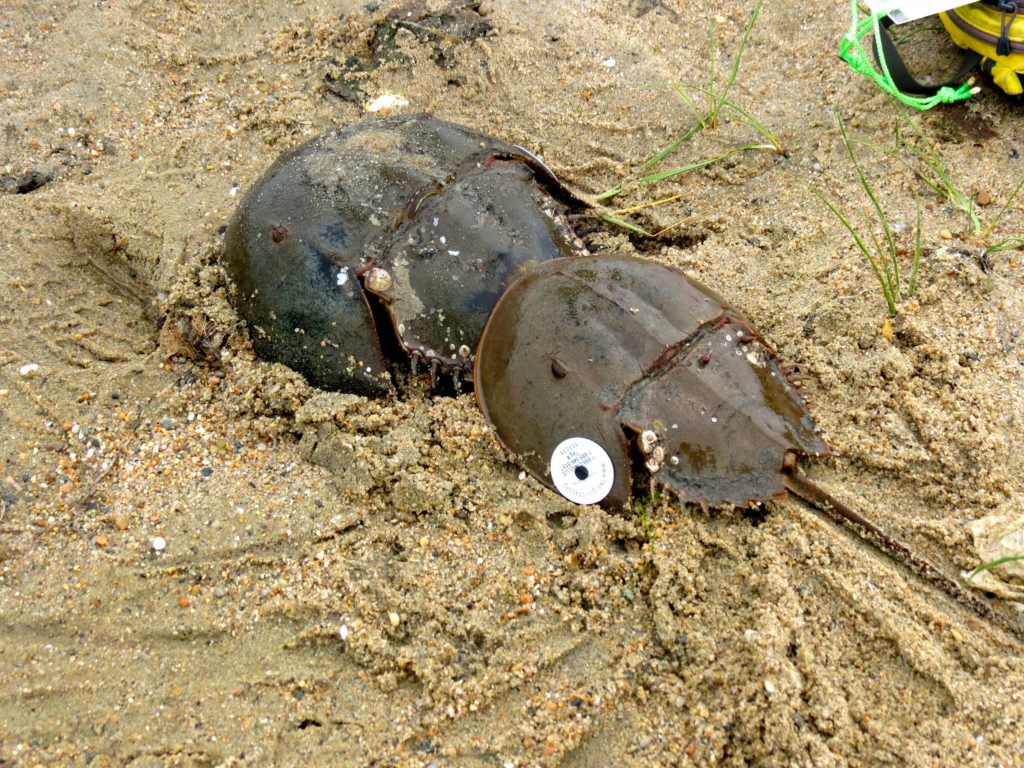
Horseshoe Crabs (Limulus polyphemus) are common on the bayside shore of Napatree. These prehistoric-looking creatures are more closely related to spiders than true crabs and have changed little in the last 445 million years. At high tides during spring and early summer, females come ashore to lay their eggs in the sand. These eggs become a critical food source for shorebirds that stop at Napatree to refuel during spring migration. Horseshoe crabs can be legally harvested, but not during May. They are used as bait for conch trapping and the medical industry. The blood of horseshoe crabs has special properties used to make sure medical products are not contaminated. Napatree Naturalists and volunteers count horseshoe crabs each summer and report these data to Project Limulus at Sacred Heart University which monitors their populations with the US Fish and Wildlife Service.
Sand Dunes
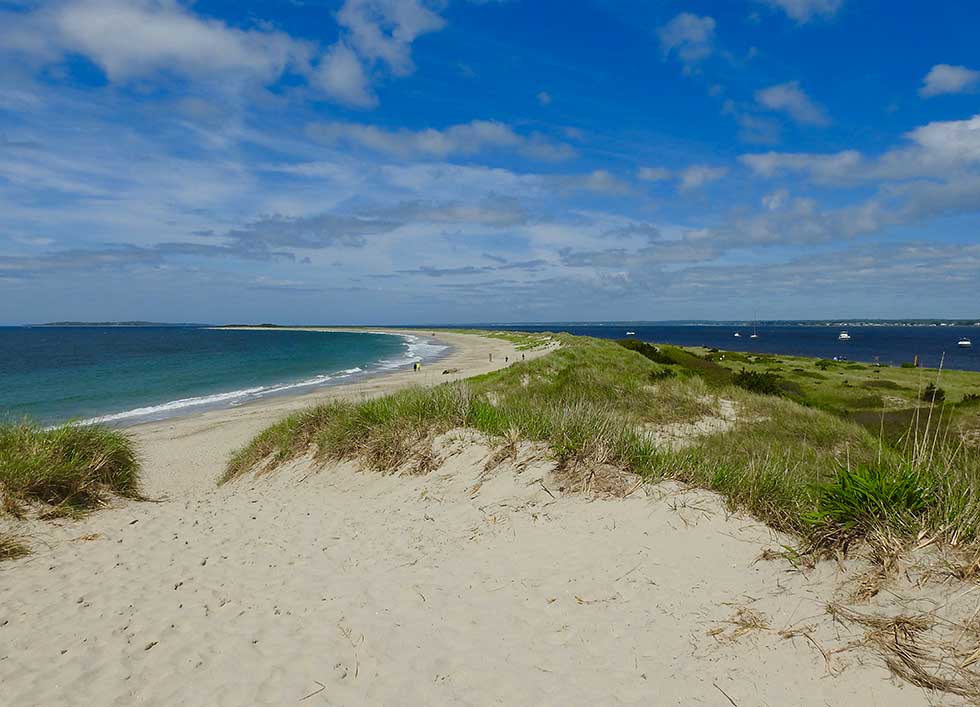
Sand dunes are the spine of the Napatree barrier. In fact, the Napatree Point Conservation Area is one of the most pristine examples of a barrier spit habitat in southern New England. Despite their simple appearance, barriers are extremely complex geological formations and are always changing. The dunes grow in the center of the barrier during calm periods between large storms as gentle winds deposit sand on them. During large storm events, wind and wave energy move sand; and in very large storms when the waves overtop the dunes, large “fans” of sand can be suddenly transported to the back of the dune (Little Narragansett Bay side). Since 1938, the Napatree barrier has moved one complete width northward into Little Narragansett Bay. Elevations of the barrier are carefully measured four times a year by Napatree scientists.
Dune Grass
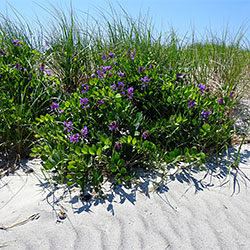
Dune grass (Ammophila breviligulata) and shrub islands (beach rose, Rosa rugosa; bayberry Morella caroliniensis) form a complex habitat on the Napatree barrier. Together they are critical habitat for mice, voles, insect pollinators, birds, and predators such as Northern Harriers, red fox, and mink. The shrub islands provide cover for animals and perching sites for birds. During gentle weather, they trap sand and build the dunes. During storm events, when overwashed by sand, their dense underground root and rhizome systems send new plant shoots to the surface as if nothing had happened. Shrub islands are getting larger and monitoring on Napatree shows them to be expanding at a rate of 0.5-1.5 feet per year. The ecology of Napatree’s plant communities is being studied by our scientists.
